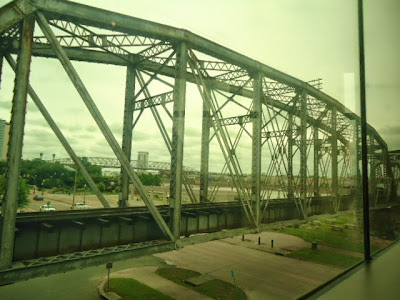Louisiana is one of the states that we'd never visited...so when presented with a few days off, we thought we'd just hop on down there and see what we could find!!
History Museum in Shreveport
Our first stop was the State Museum of Louisiana, where we learned the basic background. We learned that they have just as much oil and gas activity as Oklahoma does, and that cotton and rice were king crops for a long time.
We got to see the native wildlife, and the boys were very impressed with the pelicans. They learned that Louisiana is nicknamed the Pelican State. We also saw some historical krewe costumes from various Mardi Gras parades around the state.Science Museum at Shreveport
The Sci-Port Discovery Center was one of the ASTC membership museums, which means that we could pop in and look around for free with our card! (If you don't have a membership yet, and you travel at all, you should look into one.) We flew airplanes and learned to navigate ships by the constellations. We also played on giant pulleys, life-sized compass and protractors, and shot ourselves up into the air! Mom thought the last one was really fun!
The sky started to turn a weird shade of green, so we decided to head on down the highway and see where it took us...Fort St. Jean Baptiste in Natchitoches
This place was pretty neat for a little hole-in-the-wall! You know we love our history, and this was something we had never studied. Fort St. Jean Baptiste was a French fort and trading outpost during the French & Indian War. They have recreated the fort, complete with actors, to bring history to life! It was nice to get out of the car and walk around a bit, and we learned some science along the way when the boys stopped to ask about all the algae growing in 'de swamp.
We poked around the trading post, picking up a bit of French along the way, and learned how to make an outdoor brick oven for baking outside in the heat and humidity. We visited both the enlisted men and officer's quarters, and got to try on some of their uniforms. Did you know that it's not just the Dutch that used wooden shoes? The French wore them, too!
Le Vieux Village in Opelousas
About two hours from New Orleans, Opelousas is creole country. We visited three different museums, and learned a lot about creole history, but were only allowed to photograph in one of them. Le Vieux Village offers a glimpse of early life in St. Landry Parish. While the set up is similar to places we have visited in Michigan and Oklahoma, each region is unique, and we never tire of comparing and contrasting how the various cultures once lived...when the world was considerably more isolated.
Our trip to New Orleans fell short, due to a round of wild weather! So we hunkered down in Lafayette, Louisiana for a few days before crawling back home. But the trip wasn't wasted....no sir'ee! We learned a lot about cajuns, creoles, and our own family history!
Hungry upon arrival, we sought out a hole-in-the-wall restaurant (travel tip : always ask where the locals eat!) and enjoyed jambalaya and gumbo. Yum! There was even enough to take home for dinner. "Home" being the hotel, of course....once you've been on the road a bit, home is wherever you're crashing that night.

We stumbled upon the Acadian Cultural Center at Jean Lafitte National Park. Having an Acadian background, but not really knowing anything about it, we took this as a sign to learn more. The things we learned were fascinating!
 The Acadian Cultural Center in Lafayette tells stories of the origins, migration, settlement, and contemporary culture of the Acadians (Cajuns). They also have genealogical records, which we were able to use to trace our family back nearly three hundred years...following their path from the Pyrenees of France to current day locations.
The Acadian Cultural Center in Lafayette tells stories of the origins, migration, settlement, and contemporary culture of the Acadians (Cajuns). They also have genealogical records, which we were able to use to trace our family back nearly three hundred years...following their path from the Pyrenees of France to current day locations.
Music is such a big part of Cajun history! Cajun music and zydeco are very similar forms...Cajun music is the music of the (white) Acadians, while Zydeco is the music of the (black) Creoles. Both share common origins and influences, but each culture proudly and carefully preserves the identity of its own musical expression. Scroll down to listen to an example of each...
According to Wikipedia, "Cajun music is relatively harsh with an infectious beat and a lot of forward drive, placing the accordion at the center. Besides the voices, only two melodic instruments are heard, the accordion and fiddle, but usually in the background can also be heard the high, clear tones of a metal triangle."
 Love exploring? Check out Everyday Explorers over at SchoolhouseTeachers. There are classes to explore the USA, Canada, and Australia & New Zealand!
Love exploring? Check out Everyday Explorers over at SchoolhouseTeachers. There are classes to explore the USA, Canada, and Australia & New Zealand!The Everyday Explorers: USA course allows students of all ages to study interesting facts about the United States and its history. A different state is visited in each homeschool geography unit. There are activities, interesting facts, and links that can help the student virtually explore the areas being discussed in the day’s lesson. Map work is included as distances traveled are calculated and the weather is logged in the different areas. Activities are targeted to different grade levels so any age student can benefit from this Everyday Explorers: USA homeschool geography course. Answer keys are included where appropriate.























No comments:
Post a Comment
Note: Only a member of this blog may post a comment.